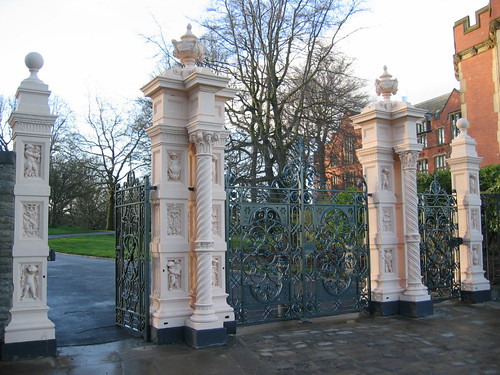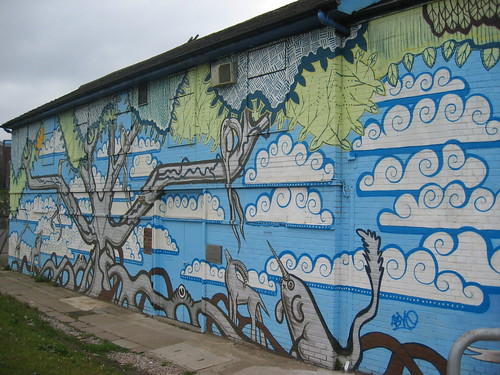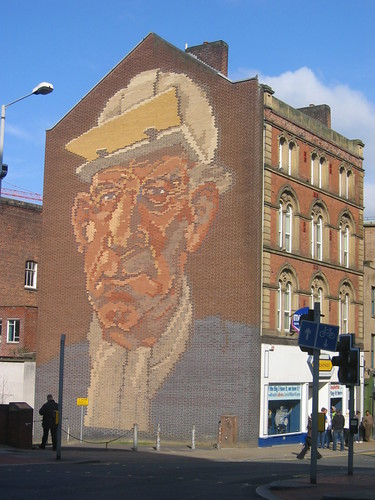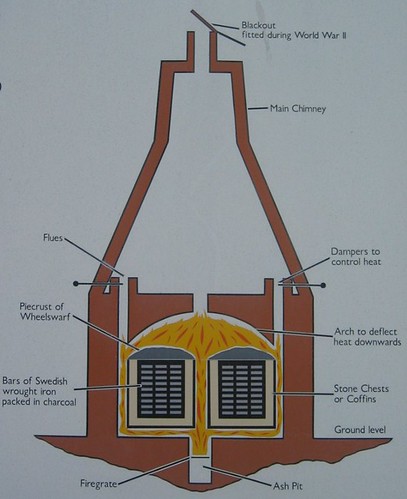According to the front page of our local paper, today is the day when it will finally happen. Other sources claim it was last week, next week or even (if a hastily formed pressure group get their way) never. What is the event that has provoked this mildly turbulent discussion? That would be the closure of Sheffield City Airport.
So far, everything I've read laments the loss of the airport, everyone seems to agree that losing it is a Very Bad Thing. Local millionaire Andrew Cook is following his principles of persistence by bankrolling a last ditch legal challenge to try to stop the runway from being dug up.
However the debate about the airport's demise is all a bit one-sided, so it's time to put the Three-Legged-Cat amongst the pigeons, because frankly, I'm absolutely delighted that the airport is closing.
Why? It's just a matter of perspective. I don't see the airport in terms of cheap holidays or benefits for local businesses. Having been unfortunate enough to live near a major airport I think of two things when I hear the word airport: noise and pollution. As a child I remember spending hours lying awake at night, trying desperately to block out the noise of the circling planes as they roared overhead - and we didn't even live under a regular flightpath. As for the pollution, the fact that I can't always see or smell the pollutants doesn't mean I forget about them.
Lets just consider what it would have been like if Sheffield's airport had been a success. It was never going to be a Heathrow or a Manchester, the runway was too short and there physically wasn't enough space for a large airport. However it could have developed into something akin to London City Airport, which may be small, but is certainly busy.
Sheffield City Airport could have handled much larger numbers of planes than it ever did, so it could have created plenty of disturbance for local residents. Pollution levels and the incidence of asthma in children in neighbouring areas were already concerns when the airport opened, I for one am pleased that we never got to see what happened if pollution from a busy airport had been added into the equation.
But Sheffield's Airport adventure never really got off the ground. There were some commercial flights for a while, but the number of destinations on offer was small. Some local businesses, including some that were somewhat less than legitimate, found that the airport was a convenient gateway to the city. Plans were made to expand the numbers of flights and for a while this happened, but it didn't last long.
Instead commercial airlines gradually pulled out, usually citing lack of profitability. The flying school that operated from Sheffield is moving to Doncaster's inexplicably named Doncaster Sheffield Robin Hood Airport. All that is left is a handful of private planes, which brings us to the real reason for Andrew Cook's campaign to save the airport. It appears that he wants somewhere convenient to land his private jet.
I don't know whether I'm being old-fashioned or far-sighted here, maybe I'm just being naive, but I don't believe that simply because someone has the money to pay for excessive air travel, then they have the right to blight other people's lives with their noise and pollution.
The bottom line is that we don't need an airport for short-haul flights, some people might want one, but that's not the same thing. To me, flying makes sense only as a means of covering long distances or to access particularly remote areas.
Personally I see Sheffield's lack of an airport as a positive asset. It was one of the reasons that I chose to move here. I'm glad it's gone.
/climbs off high horse
/ends rant
--
Originally published here on my main blog http://three-legged-cat.blogspot.com/
Comments on the original post
Wednesday, 30 April 2008
Sunday, 27 April 2008
They're Back!
As soon as I rashly commented on their long absence, they returned! On Thursday I passed Weston Park and realised that the gates are back. As you can see, they are looking pretty good.
The original gates were stolen in 1994, I'm pretty certain that these are replacements - I'll update this post when I find out for sure.
 However I have to take issue with the information monolith/minilith just outside the park.
However I have to take issue with the information monolith/minilith just outside the park.Weston Park Gates
Terracotta park gates, posts and railings are a tribute to the Sheffield artists who in 1859 worked on London's V&A Museum led by Godfrey Sykes, a teacher at the Sheffield School of Art. His work can still be seen, notably in the tea-rooms.
Terracotta park gates? I don't think so! The pillars are terracotta, but most definitely not the actual gates.
--
Originally published here on my main blog http://three-legged-cat.blogspot.com/
Comments on the original post
Tuesday, 22 April 2008
Phlegmatic
Our new section of relief road is proving fairly popular with drivers, but it has created a real challenge for the RSPCA in Sheffield, who were forced to close their animal shelter when the road was built. Fund raising for a new centre is underway in the form of Monty's Appeal, but in the meantime facilities in Sheffield are restricted.
At present a small building close to the original site is being used for kennels. This was a spectacularly ugly building until last summer, when it received the Phlegm treatment.
I pass it twice a day but I can't really get more than a fleeting glimpse when I'm travelling past, so we decided to go and take a closer look at the weekend.
The artwork is great, but Mr TLC had to drag me away - the sound of all those dogs howling was heart rending, but that may have been partly because it was breakfast time.
Links- updated
Meet Phlegm - he introduces himself to the readers of fatcap, a graffiti blog
Phlegm's blog
Phlegm's official art site includes some great photos
--
Originally published here on my main blog http://three-legged-cat.blogspot.com/
Comments on the original post
At present a small building close to the original site is being used for kennels. This was a spectacularly ugly building until last summer, when it received the Phlegm treatment.
I pass it twice a day but I can't really get more than a fleeting glimpse when I'm travelling past, so we decided to go and take a closer look at the weekend.
The artwork is great, but Mr TLC had to drag me away - the sound of all those dogs howling was heart rending, but that may have been partly because it was breakfast time.
Links- updated
Meet Phlegm - he introduces himself to the readers of fatcap, a graffiti blog
Phlegm's blog
Phlegm's official art site includes some great photos
--
Originally published here on my main blog http://three-legged-cat.blogspot.com/
Comments on the original post
Labels:
Architecture,
Art,
Central Sheffield,
Graffiti,
Phlegm
Saturday, 19 April 2008
What KT Did
 Do you want to know a secret? KT Tunstall has an imaginary friend. I know this because she told me about him. Only she doesn't know that her friend is imaginary, she thinks he's real.
Do you want to know a secret? KT Tunstall has an imaginary friend. I know this because she told me about him. Only she doesn't know that her friend is imaginary, she thinks he's real.Of course I haven't actually been hanging out with KT herself, she told me and a couple of thousand other people about this whilst she was onstage at the new Carling Academy in Sheffield on Wednesday. This was our first visit, we weren't quick enough off the mark for the opening night (which sold out alarmingly quickly) about which there were mixed reports. I was a little worried by James' description of a 30 minute wait to get served at the bar, but fortunately the first night teething problems seem to have been resolved.
The Carling Academy occupies the building that was once The Roxy nightclub (or if you are really old, you may even remember it as the Top Rank). Apart from a brief and unlikely stint as a church, the building has been empty and quietly mouldering away for years. It's a fairly large venue, so I can believe the reports that around £3 million has been spent on renovating it.
Outside still looks much the same, except for the name change. Inside will also be familiar to anyone who visited the old Roxy (I believe I just made an implicit admission there, but we'll gloss over that). The building is basically a square, with a stage on the ground floor, the first floor is essentially an enormous gallery that overlooks what was once the dance floor (and probably still is on club nights).
What has changed? The stage seems a bit bigger than I remember, obviously there is now a ginormous mixing desk with a squillion controls, there is some seating along the back wall but the strange little circular banquettes that provided a venue for drunk people to get embarrassingly over-amorous have gone. The whole place has been decorated, refurbished and generally spruced up, even the toilets were clean and in working order. However, I was amused to note that the designer has retained one key feature from the old Roxy: a sticky carpet that clings slightly to your shoes as you walk across it. OK, it's not the original sticky carpet, but it represents a small piece of Sheffield's heritage nonetheless :)
There are of course lots of bars, selling lots of Carling (and one or two other beverages), and unlike James, we were served instantly. Marvellous. The beer wasn't even as expensive as I feared, do you think they get a discount on Carling?
 The gig was great. KT Tunstall was in fine form playing a selection of both new and not-so-new material. In between songs she chatted with the crowd, telling us about the inspirations for her songs, her opinions on plastic surgery, random facts (things invented by women) and of course her love of condiments.
The gig was great. KT Tunstall was in fine form playing a selection of both new and not-so-new material. In between songs she chatted with the crowd, telling us about the inspirations for her songs, her opinions on plastic surgery, random facts (things invented by women) and of course her love of condiments.As soon as she mentioned this, we knew what was coming next. She's talked about it before, her passion for the unique Sheffield brew that is Henderson's Relish. If you have ever lived in Sheffield you will understand the legendary status of this humble sauce. If you haven't, well it's a bit hard to explain, you'll just have to take my word for it.
KT has clearly fallen in love with the stuff (at least, that's what she tells her Sheffield fans) and is very envious of the likes of Sean Bean and Richard Hawley, who appear on the famous fan's section of the Henderson's website. She even dedicated a song to the man who works in the Henderson's Factory. That's when I realised that something was slightly amiss with Miss T, in fact KT has been letting her imagination run a little wild.
I hate to be the one to break the bad news KT, but there isn't a man who works in the Henderson's factory. No-one works in the Henderson's factory. No-one at all. The relish is definitely made at the factory - you can smell it, but it is obviously brewed up in some strange, magical process, untouched by human hand. No-one has ever been seen arriving or leaving the Henderson's factory. It's a mysterious little place.
Normally I'd feel guilty about shattering someone's illusions, but I can't imagine that KT Tunstall is lurking out there reading this, so I think I'm safe...
I have to say that I was pretty impressed with the Carling Academy, both with the venue itself and the staff - it's been a long time since I was last greeted in a polite and friendly way by security staff at a gig. I'm quite sure that Wednesday will be the first of many visits for us.
--
Originally published here on my main blog http://three-legged-cat.blogspot.com/
Comments on the original post
Bower Springs
 I thought I'd show you another stop on the Kelham Furnace Trail. At Bower Spring (do not be misled by the idyllic-sounding name) are the remains of two cementation furnaces.
I thought I'd show you another stop on the Kelham Furnace Trail. At Bower Spring (do not be misled by the idyllic-sounding name) are the remains of two cementation furnaces.Unlike the nearby Doncaster Street furnace, these are ruined, so you can see inside. Unfortunately that is not the only difference between the two sites: these furnaces are on a site that does not appear to be particularly well cared for, neither are they very welcoming for visitors at the moment.
Bower Spring is adjacent to the new section of the Inner Relief Road. The road avoided the furnaces, but the site is littered with junk that has apparently been left behind by the road's builders: traffic cones, roadworks signs, buckets, discarded clothing and other assorted litter are all strewn around the site.
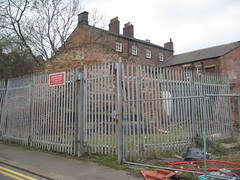 The furnaces are a scheduled monument, so they are are fenced off - and quite right too. The furnace structure needs protection and the unwary visitor could easily cause damage to themselves or to the remains on the site. Unfortunately the manner in which the area is currently fenced off is awful - it is a mixture of security fencing and partially collapsed temporary fencing of the type that normally surrounds building sites. In short it is both ugly and ineffective, plus it obscures the ruined furnaces. I hope that this situation is just a temporary hangover from the construction of the new road.
The furnaces are a scheduled monument, so they are are fenced off - and quite right too. The furnace structure needs protection and the unwary visitor could easily cause damage to themselves or to the remains on the site. Unfortunately the manner in which the area is currently fenced off is awful - it is a mixture of security fencing and partially collapsed temporary fencing of the type that normally surrounds building sites. In short it is both ugly and ineffective, plus it obscures the ruined furnaces. I hope that this situation is just a temporary hangover from the construction of the new road.The only concession to visitors seems to be a sign, mounted high on the security fence:
"Bower Spring Furnaces
These remains of 19th cent[ury] furnaces for making cementation steel are a scheduled monument.
They belong to the South Yorkshire Industrial History Society.
Contact point: Kelham Island Industrial Museum."
These remains of 19th cent[ury] furnaces for making cementation steel are a scheduled monument.
They belong to the South Yorkshire Industrial History Society.
Contact point: Kelham Island Industrial Museum."
It seems that it is not just the Furnace Trail web link that is not yet ready for visitors, this part of the actual trail is currently somewhat less than welcoming.
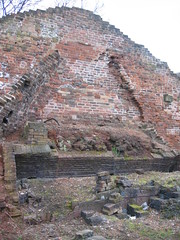 However, despite the sorry state of the site, it is still most definitely worth stopping to look. Where else could you can see exactly what a cementation furnace was like inside?
However, despite the sorry state of the site, it is still most definitely worth stopping to look. Where else could you can see exactly what a cementation furnace was like inside?These furnaces were obviously much smaller than the one on the Doncaster Street site, I found it hard to imagine how cramped the working conditions must have been. One furnace has been reduced to little more than a tell-tale outline on the wall at the back of the site, but the other is still partially intact.
One of the stone coffins is still in place, this is a large chest that held the iron bars and charcoal which were converted to blister steel during the cementation process. Next to the coffin are brick built structures which were part of the flue system. A small section of the furnace wall is still standing, as is part of the vaulted section over the coffin - the surface of which is heavily glazed from the heat experienced during firing. Away from the furnace itself, some brickwork hints at the existence of the cellar, where the coal was fired to heat the furnace. The holes in the picture below almost certainly belonged to a completely different type of furnace: crucible furnaces were often found along cementation furnaces, including at this site. The whole structure resembles a kind of 3D cut away model.
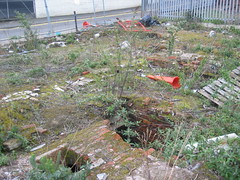 The Doncaster Street furnace is impressive, but left me wanting to see inside, here it is possible to do exactly that.
The Doncaster Street furnace is impressive, but left me wanting to see inside, here it is possible to do exactly that.Links
This furnace is part of the Kelham Furnace Trail. A leaflet describing the trail is available from local bookshops, including the one at Abbeydale Industrial Hamlet. The leaflet gives a link to Upper Don Walk trust's site but there don't seem to be details of The Furnace Trail online just yet.
All my posts about the Kelham Furnace Trail
My Flickr photoset for this furnace
The Winter 2005/06 edition of the Historical Metallurgy Society's newsletter includes an article about Bower Springs and the archaeological research carried out here before the road was built. [pdf document]
Events listings for the South Yorkshire Industrial History Society
--
Originally published here on my main blog http://three-legged-cat.blogspot.com/
Comments on the original post
Sunday, 13 April 2008
Culture Vultures
 After I wrote about the steelworker mural the other day, I suddenly remembered the vultures.
After I wrote about the steelworker mural the other day, I suddenly remembered the vultures.I used to love walking past the vultures. Part way down Arundel Gate in Sheffield was an end wall with a brick mural of four vultures. Like the steelworker, this was also commissioned by Sheffield City Council, but this one was built six years earlier than the steelworker, in 1980 and was designed by Ric Bingham, from the Landscape and Planning Department.
I used to play a kind of mental game every time I passed the vultures. As a child, I was given a copy of the soundtrack to Walt Disney's Jungle Book. One track on the record was the scene with the four vultures."What we gonna do?""I dunno, what d'you wanna do?" I loved it, I learned it off by heart, although I wasn't so keen on the song that formed the second part of the track - the start of that was a lift the stylus off the record moment.
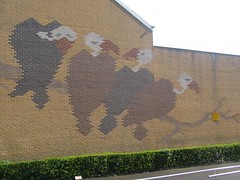 When I arrived in Sheffield and spotted this particular mural it immediately brought back childhood memories and had me playing the scene from the Jungle Book in my head. I don't know if Disney's vultures were any kind of inspiration for this mural, but I always associate the two.
When I arrived in Sheffield and spotted this particular mural it immediately brought back childhood memories and had me playing the scene from the Jungle Book in my head. I don't know if Disney's vultures were any kind of inspiration for this mural, but I always associate the two.So why hadn't I thought about or noticed my feathered friends lately? Were they still there, or had they fallen victim to the major redevelopments in that part of town? I went back to check them out. They are still there, but whereas once they were a focal point in a run down area, now they are slightly overpowered by the large new buildings around them. In fact, the four culture vultures sit just across the road from one of my newer friends the Millennium Galleries, surveying the relative newcomer that has temporarily grabbed my attention.
I'm probably not the only one who has been overlooking them, whilst I was snapping away taking some photos, other people stopped to look; but then, maybe that was just because I was re-enacting a certain movie scene for the benefit of Mr TLC. Unfortunately, Mr TLC had wandered off to sit on a bench just down the road, something I had completely failed to notice. I'd like to think that the people who stopped were looking at the mural, and not at the crazy woman having a conversation with herself in a fake Liverpool accent.
"Now don't start that again!"
--
Originally published here on my main blog http://three-legged-cat.blogspot.com/
Comments on the original post
Saturday, 12 April 2008
Everything Must Go
The fate of one of Sheffield's best known, but most controversial, landmarks is sealed. Sometime this year the two cooling towers that stand next to the M1 will be demolished. Some people will be happy to see them go, but I won't, I love them.
The two Toms (Tom James and Tom Keeley) had spearheaded a strong campaign to convert the towers into massive new artworks, but sadly it was not to be. So they marked the impending demise of the towers by organising a closing down sale of specially commissioned memorabilia, held in the Millennium Galleries. It proved to be extremely popular. The sale was supposed to run for up to two weeks, but everything sold out in less than a day, which shows how well loved these landmarks are.
I really hope that Tom James and Tom Keeley do remain involved in the debate over the artwork that is planned for part of the site after the towers are demolished. I can understand just how frustrated they feel about the way things have turned out, but whilst we have missed the opportunity to create an amazing artspace that would have attracted visitors to Sheffield, there is still the chance to create something that could be a new icon for the city.
If the two Toms make their voices heard, we might just still see something great created here, rather than just yet another missed opportunity.
--
Originally published here on my main blog http://three-legged-cat.blogspot.com/
Comments on the original post
The two Toms (Tom James and Tom Keeley) had spearheaded a strong campaign to convert the towers into massive new artworks, but sadly it was not to be. So they marked the impending demise of the towers by organising a closing down sale of specially commissioned memorabilia, held in the Millennium Galleries. It proved to be extremely popular. The sale was supposed to run for up to two weeks, but everything sold out in less than a day, which shows how well loved these landmarks are.
I really hope that Tom James and Tom Keeley do remain involved in the debate over the artwork that is planned for part of the site after the towers are demolished. I can understand just how frustrated they feel about the way things have turned out, but whilst we have missed the opportunity to create an amazing artspace that would have attracted visitors to Sheffield, there is still the chance to create something that could be a new icon for the city.
If the two Toms make their voices heard, we might just still see something great created here, rather than just yet another missed opportunity.
--
Originally published here on my main blog http://three-legged-cat.blogspot.com/
Comments on the original post
Wednesday, 9 April 2008
A Man of Steel
I thought I'd show you one of Sheffield's best known faces. I can't tell you who he is, but I can tell you that this brick mural was based on the image of a real steelworker. Some adaptations to the man's appearance were made to allow the image to be created from coloured bricks.
"The eyes had to be enlarged, for example, or the pupils and the whites would have been smaller than a brick."
Paul Waplington
After an adjoining building was demolished, the City Council commissioned artist Paul Waplington to design the mural. The Council's Works Department then constructed it.
What are this image's vital statistics? Estimates seem to vary: everyone quotes the number of bricks used at 30000 and the number of types of mortar used is usually given as 5. The number of different types of bricks that were used is unclear - some sources say 12, others 18. I tried to count them for myself and came up with a different figure, so I won't add to the confusion! The differences in the colours of the various mortars seem to have become less noticeable over time, perhaps the same has happened to some of the bricks.
The mural was built in 1986, the year when I moved to Sheffield. There is another great shot of it here.
--
Originally published here on my main blog http://three-legged-cat.blogspot.com/
Comments on the original post
Tuesday, 8 April 2008
The Last of its Kind
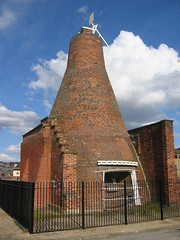 Travellers using Sheffield's Inner Ring Road might just catch a glimpse of part of the city's industrial heritage. Standing in HSBC's car park on Doncaster Street is the only complete cementation furnace left in Sheffield. The furnace is a large bottle shaped structure, outwardly similar to the bottle kilns used by pottery manufacturers. It is an unusual structure, very different to everything around it, but it is constructed from red brick, so it is surprisingly easy to pass by without even noticing it.
Travellers using Sheffield's Inner Ring Road might just catch a glimpse of part of the city's industrial heritage. Standing in HSBC's car park on Doncaster Street is the only complete cementation furnace left in Sheffield. The furnace is a large bottle shaped structure, outwardly similar to the bottle kilns used by pottery manufacturers. It is an unusual structure, very different to everything around it, but it is constructed from red brick, so it is surprisingly easy to pass by without even noticing it.The cementation process combined carbon with iron to create bars of blister steel - named for the characteristic blisters on its surface. The process involved heating wrought iron bars and charcoal. The raw materials were packed in layers into two large sandstone chambers, known as coffins, which were sealed off with a mixture of clay and waste from grinder's wheels before the furnace was fired. The entrances to the chambers (known as charging holes) were also sealed up with bricks and clay.
The furnace was coal fired and heated the iron until it was red hot, but not molten. Once heated to this state, the iron softened and reacted with the carbon in the charcoal to form steel. Firing was a lengthy process typically lasting for around 7-10 days, followed by several more days of cooling before anyone could enter the furnace to remove the newly formed blister steel. The furnace had a surprisingly large capacity - a plaque at the site reports it at 40 tons. Let me put that in perspective for you: as an engineering student (studying metallurgy and materials science), I did a work placement at a local company that still makes special steels for the aerospace industry; their furnace had a capacity of 10 tonnes, although the firing was a lot faster than at Doncaster Street.
Blister steel was an important product in the Sheffield steel industry that was used to make a variety of tools. Unfortunately it also contained impurities which adversely affected the quality of the steel. Huntsman's crucible process could remove many of the impurities in blister steel to create a much better quality product - but more about that another time.
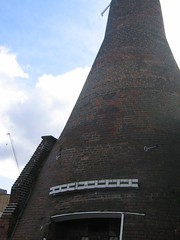 The Doncaster Street furnace was built in around 1848 and was one of five operated by Daniel Doncaster, a well known local steelmaking company. It was last fired in 1951.
The Doncaster Street furnace was built in around 1848 and was one of five operated by Daniel Doncaster, a well known local steelmaking company. It was last fired in 1951.One interesting feature of this particular furnace is the slightly odd structure on the top. This dates from World War II (although it has been restored somewhat). The top of the flue would be easily visible during firing, but given that the firing lasted for days and couldn't be stopped at short notice, a method of concealing the flue was needed. The solution was basically a metal flap that could swing down to cover the top of the flue in event of an air raid. The flap is attached to a frame and has a lever to assist in lowering it. I suspect that actually operating this when the furnace was being fired would be quite difficult.
The furnace is in very good condition, having been restored by Midland Bank (now HSBC) during the early nineties. It is fenced off (no bad thing), so it is not readily accessible, but it is easily visible. The sign states that a key is available on request from the curator of Kelham Island Museum - although the phone number is out of date and the museum is still recovering from flood damage, so we didn't try this. It didn't matter - we had a good view of the furnace from the street and from just inside the bank's car park. We visited on a Sunday, when few people were working there, I don't know if the same relaxed attitude to sightseers would apply in the week.
I'd love to actually get inside it, but somehow I suspect that wouldn't be allowed.
Links
This furnace is part of The Furnace Trail. A leaflet describing the trail is available from local bookshops, including the one at Abbeydale Industrial Hamlet. The leaflet gives a link to Upper Don Walk trust's site but there don't seem to be details of The Furnace Trail online just yet.
All my posts about the Kelham Furnace Trail
My Flickr photoset for this furnace
--
Originally published here on my main blog http://three-legged-cat.blogspot.com/
Comments on the original post
Labels:
Industry,
Kelham Furnace Trail,
Netherthorpe,
Steel
Monday, 7 April 2008
A Trip to The Moon
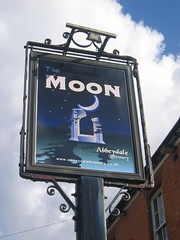 During my school holidays I visited somewhere just because I thought it sounded cool, but because I have been dashing around like a lunatic and moonlighting as a joiner I have been a bit short on time and I completely failed to tell you about it.
During my school holidays I visited somewhere just because I thought it sounded cool, but because I have been dashing around like a lunatic and moonlighting as a joiner I have been a bit short on time and I completely failed to tell you about it.Where did I go? I went to The Moon! No, not that Moon, this Moon. Yes, I really took a trip to The Moon! How many people can say they’ve done that?
The Moon is a rather nice pub in Upperthorpe, Sheffield. It actually opened many moons ago, but we only visit this area once in a blue moon, so it’s taken us a while to get around to a Moon landing.
The Moon is owned by the Abbeydale Brewery. It used to be called The Office, but the name was changed when Abbeydale took over. It has a sister pub, The Rising Sun (which has retained its original name). Ah, I get it.
Abbeydale Brewery produce a range of real ales and unsurprisingly The Moon has plenty of them available. When we visited 8 out of the 10 hand-pulled beers on offer were Abbeydale brews, with a couple of guest beers from other breweries.
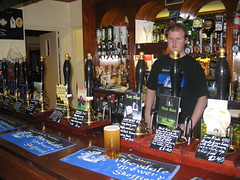 I foolishly just read the descriptions and started (rather inappropriately) with a half pint of Last Rites, simply because it sounded nice. It was nice, but it was also exceptionally strong at 11%. Blimey, I must pay more attention in future. Mr TLC was tempted by Bee Ale Z Bub; a pun so bad that the barman in The Moon felt the need to apologise for it. Of course he didn’t realise that we were only there to try to out-pun each other.
I foolishly just read the descriptions and started (rather inappropriately) with a half pint of Last Rites, simply because it sounded nice. It was nice, but it was also exceptionally strong at 11%. Blimey, I must pay more attention in future. Mr TLC was tempted by Bee Ale Z Bub; a pun so bad that the barman in The Moon felt the need to apologise for it. Of course he didn’t realise that we were only there to try to out-pun each other.- “Look at that moon light,” I said, pointing at the ceiling.
- “Listen, they’re playing some moon rock,” retorted Mr TLC
- “It’s not a full Moon is it, it's pretty quiet in here, but it is Sunday afternoon.”
- “Are you saying there’s no atmosphere in here?”
Shameless, we were.
Despite the fact that we only really visited for the name, I rather liked it there. We spent a pleasant couple of hours trying various Abbeydale brews. The beer was nice, the staff were friendly and the atmosphere in the pub was very relaxed. The only disadvantage for us is the location: it’s only about 30 minutes walk from our house, but that was a long moon walk uphill after I had recklessly drunk excessively strong beer in the middle of the afternoon.
--
Originally published here on my main blog http://three-legged-cat.blogspot.com/
Comments on the original post
Subscribe to:
Comments (Atom)
